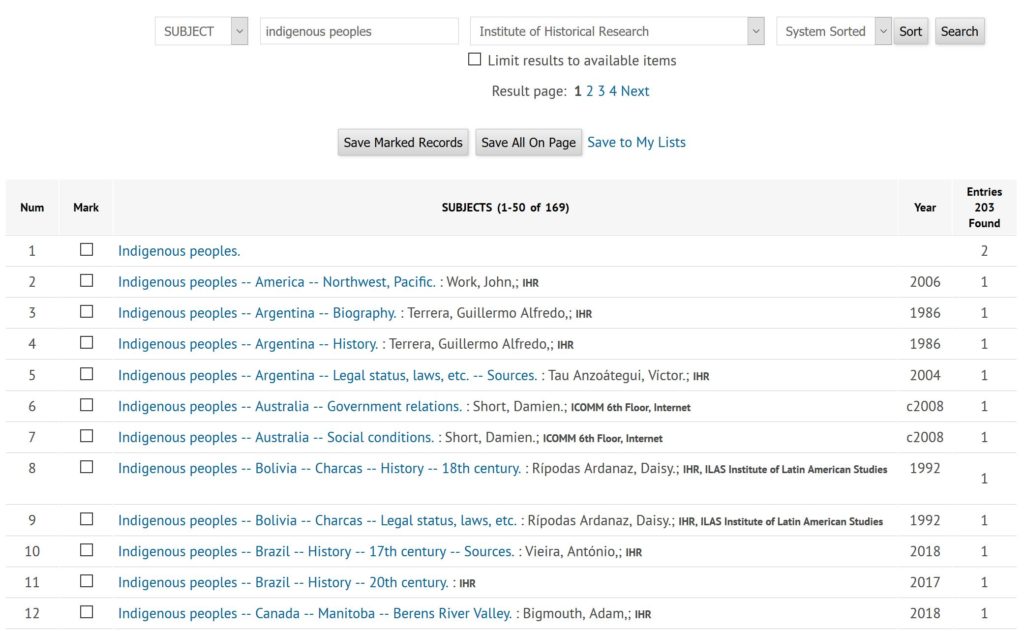By Michael Townsend
In February of this year we outlined in Diversity and inequality in the library the measures the IHR library is taking to make its spaces and resources open to all. What follows is a further look into one specific aspect of this general objective: subject headings. Subject headings are a set of controlled terms set by the Library of Congress (other controlled vocabularies exist) that appear on the vast majority of records on our catalogue and are usually a useful tool for finding specific items or determining the extent of a particular subject in our collections. However, they do have their limitations. This is something myself and colleagues elsewhere have been aware of for some time; while researching a paper that I delivered at History Day in 2015 I became conscious of how the language used in classification schemes and subject headings can actually obscure subjects within collections, ultimately placing an obstacle between the information and the researcher. Since then, as a matter of maintenance, I have been examining the headings in our records, evaluating if the language used is no longer helpful, even offensive, and finding alternatives. Considered below is a single example in this broader process, highlighting what has been done and what still needs to be tackled.
“Indians of…”
One jarring example of that was prevalent in the catalogue’s records was the heading beginning with ‘Indians of…’. Although many over-arching terms are used to describe the diverse societies of both North and South America (i.e. First Nation, Aboriginal, Native American, etc.), “Indian” was not one of them. This issue with relation to classification schemes and subject headings appears periodically in the literature (Olson, 1999), (Tomren, 2003), (Kam, 2007).

One particularly useful study is by Christine Bone (2016), which discussed the changes the Association for Manitoba Archives made to the subject headings to better reflect the First Nation material they have. Among the steps which she and her team adopted was to drop the term ‘Indian’ altogether and opt for the alternative, ‘Indigenous peoples’. This was applied to their items, ‘for all the peoples of the Americas, not just when describing people in Canada.’ This too is the strategy adopted in the IHR Library. The examples below show how this has been applied:
| Old Heading | New Heading |
| Indians of Central America – Guatemala – Legal status, laws, etc. | Indigenous peoples – Guatemala – Legal status, laws, etc. |
| Indians of South America – Brazil – History – 17th century – Sources. | Indigenous peoples – Brazil – History – 17th century – Sources. |
Although this is an improvement some drawbacks remain, most glaring of which is the geographic terms used. The political geographies set by western colonial powers do not necessarily marry with the geographies of indigenous Americans; the Apache territories straddled the southwest United States and northern Mexico while communities of modern Maya span the borders of southern Mexico and Guatemala. To remedy this, multiple headings can be added to a record, covering all the political states relevant to a work. For instance a work of published sources on Iroquois history could have two headings for the United States and Canada or, perhaps simpler, just one for North America:
Indigenous peoples – Canada – History – 18th century – Sources.
Indigenous peoples – United States – History – 18th century – Sources.
or
Indigenous peoples – North America – History – 18th century – Sources.
Raising the example of the Iroquois presents another issue; one of the name of a particular people or peoples. Returning to Christine Bone’s work in Manitoba, her team agreed that the term ‘Indian’ should be removed from subject headings for the names of individual societies (i.e., Ojibwe, not Ojibwe Indians). I too would like to adopt this stance and I will consult with my colleagues both in the IHR’s library team and in Senate House Library. Another issue I seek to raise with them is the names of the peoples themselves: should the term ‘Iroquois’ be used, for example, or should subject headings be determined by the names the peoples call themselves, in this case ‘Haudenosaunee’.
Therefore, there is still much to do in this one area alone, and maintenance will be on-going to keep current with any changes to the nomenclature (in all areas, not just indigenous history). But, by abandoning out-dated terms, the catalogue will become a fairer and more effective tool for researchers in the future. And as this process has gone on, one rather positive result has been discovering the growing extent of material in the library on the indigenous peoples of North and South America. A guide to these materials will be added to our collection guides in due course.
References
Bone, Christine, 2016. ‘Modifications to the Library of Congress Subject Headings for use by Manitoba Archives’, paper presented at: IFLA WLIC 2016, http://library.ifla.org/1328/1/151-bone-en.pdf
Kam, D. Vanessa, 2007. ‘Subject headings for aboriginals: the power of naming’ Art documentation: journal of the Art Libraries Society of North America, volume 26, pp. 18–22
Olsen, Hope A., 1999. ‘Cultural discourses of classification: indigenous alternatives to the tradition of Aristotle, Durkheim, and Foucault’ Advances in classification research, volume 10, pp. 91–106
Tomren, Holly, 2003. ‘Classification, bias, and American Indian materials’, working paper (San Jose: San Jose State University), http://ailasacc.pbworks.com/f/BiasClassification2004.pdf
Michael Townsend is Collections and Metadata Librarian at the Institute of Historical Research. Follow him @MichaelRTownsend

